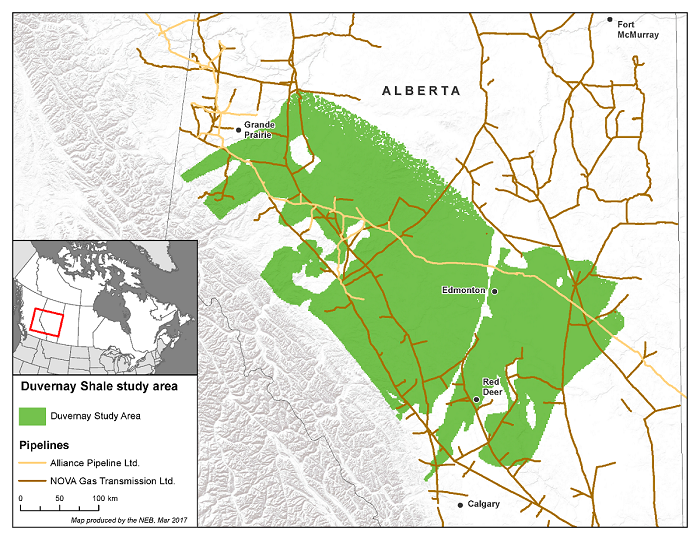Market Snapshot: The Duvernay Shale in Alberta has significant potential for oil and natural gas
Release date: 2017-09-26
The NEB, using geology and in-place hydrocarbon information determined by the AGS, estimates Alberta’s Duvernay Shale has the potential to produce 3.4 billion barrels of marketable crude oil, 76.6 trillion cubic feet of marketable natural gas, and 6.3 billion barrels of marketable natural gas liquids (NGLs).
The Duvernay Shale was deposited as organic-rich mudstone, a fine-grained rock, that extends beneath 130 000 square kilometers of Alberta, or about 20% of the province. Tight natural gas and oil resources are trapped in the fine pores of the rock, and can be extracted through a combination of horizontal drilling and hydraulic fracturing. The Duvernay’s resources are located near existing pipelines, including natural gas pipelines that connect natural gas markets within Canada and between Canada and the United States (U.S.).
The Duvernay Shale in Alberta
Source and Description
Source: NEB
Description: This map illustrates the location of the Duvernay Shale study area in Alberta. The formation lies beneath ground near Grand Prairie, stretching along the foothills, past Red Deer. Superimposed on the map are the pipelines owned by Alliance Pipeline Ltd. and NOVA Gas Transmission Ltd.
The Duvernay Shale is expected to have more marketable oil resource (3.4 billion barrels) than the Bakken Formation in Saskatchewan (1.4 billion barrels) and Montney Formation in Alberta and B.C. (1.1 billion barrels). However, the Duvernay’s oil resource is much smaller than the remaining bitumen reservesFootnote 1 in Alberta’s oil sands (165 billion barrels). The Duvernay’s marketable gas resource (76.6 Tcf) is smaller than other unconventional gas resources in the Western Canada Sedimentary Basin, such as the Montney Formation (449 Tcf), Liard Basin – (219 Tcf) and Horn River Basin (78 Tcf).
| Marketable Resource | Metric Gas: trillion m³ Oil and NGLs: billion m³ |
Imperial Gas: Tcf Oil and NGLs: billion barrels |
||||
|---|---|---|---|---|---|---|
| Low | Expected | High | Low | Expected | High | |
| Gas | 0.963 | 2.168 | 3.713 | 34.021 | 76.567 | 131.132 |
| Oil | 263.1 | 542.2 | 895.0 | 1.655 | 3.411 | 5.629 |
| NGLs | 446.7 | 994.6 | 1699.5 | 2.810 | 6.256 | 10.690 |
| Ethane | 241.1 | 539.5 | 922.0 | 1.516 | 3.394 | 5.799 |
| Propane | 116.0 | 257.85 | 440.2 | 0.730 | 1.622 | 2.769 |
| Butane | 57.1 | 126.41 | 215.4 | 0.360 | 0.795 | 1.355 |
| Pentanes plus | 32.3 | 70.81 | 120.14 | 0.203 | 0.456 | 0.756 |
Source and Description
Source: NEB
Description: This table shows the assessed marketable resource broken down into natural gas (in trillion cubic meters and trillion cubic feet), oil (in billion cubic meters and billion barrels), and NGLs (in billion cubic meters and billion barrels) – ethane, propane, butane, and pentanes plus. Uncertainty in the estimates is reflected by the spread between estimated low and high values.
“Low” and “high”, as used here, refer to a range where there is reasonably high confidence that marketable volumes from the Duvernay shale will fall inside it.
- Date modified:

